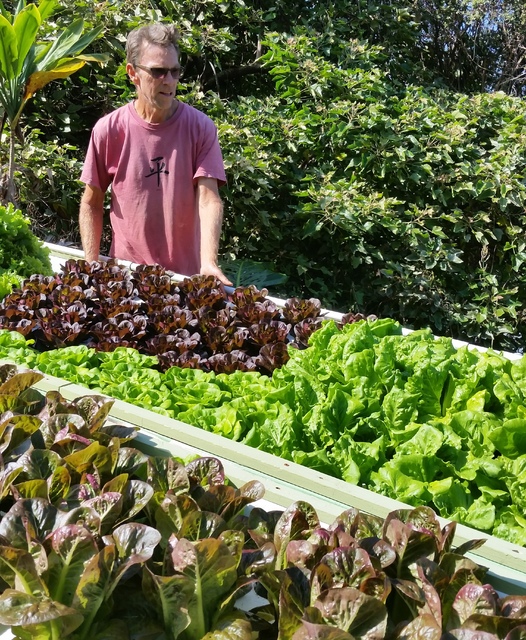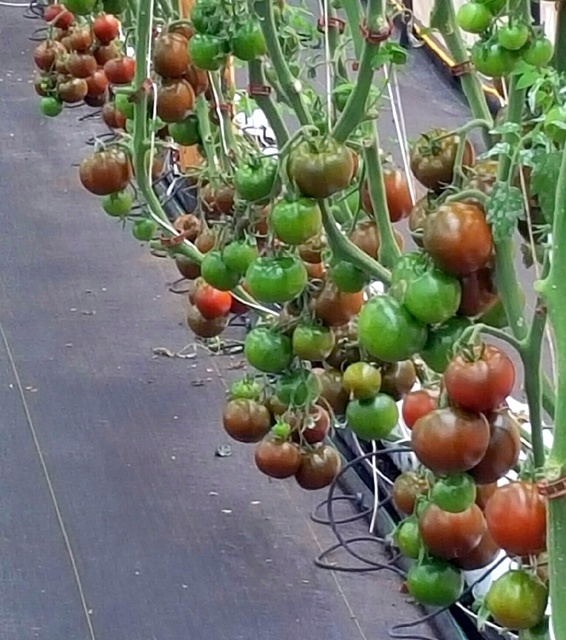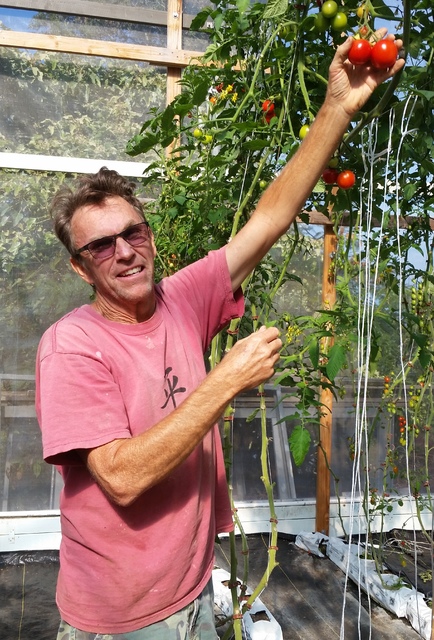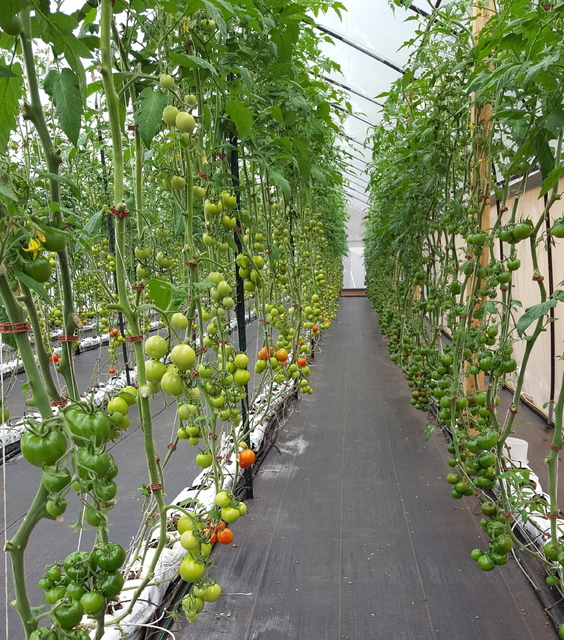Science behind sweet, savory tomatoes
SOUTH KONA — If you long for the full flavor of a garden fresh tomato, you might be able to satisfy that desire with one of Stan Lyon’s Cherokees.
When ripe, these tomatoes have bright red bottoms and a green blush at the stem. Unlike my grandmother’s huge, sweet, crimson specimens, this recently recovered heirloom comes very close to the taste I remember from a bygone era.
Stan has tomato farming down. I was struck by how labor intensive his operation is, but the results are worth the effort. On a piece of hillside in South Kona that he and his wife, Kitty, bought 15 years ago, Stan has carved out terraces for his home, two large screen houses and a hydroponic lettuce garden. Their Malamalama Farm is now precisely managed and yielded more than 20,000 pounds of produce last year. As more growing space is added and Stan’s operation becomes even more efficient, he expects that number to increase annually.
Stan grew up in the small farming community of Rockyford, Colorado, which is famous for growing tasty cantaloupe and watermelon. Though his family didn’t farm, he certainly developed an early appreciation for flavorful fruit. This is perhaps what inspired him to make plans to travel and do some worldwide tasting in his future. His first job out of college was in Arizona where he taught reading to Navajo kids and coached them in basketball. Soon, the travel bug got to him and he began collecting and selling gemstones, internationally. In the early 1980s, he decided he needed a home base and chose to establish one in Hawaii. In 1982, after meeting Kitty, he settled further into his base and took a job roasting coffee for Tommy Greenwell. That job morphed into a few farm managing gigs and some specialty coffee growing for Greenwell.
He was going full bore grafting Kona typica trees onto nematode resistant African root stock when the coffee berry borer arrived. The discovery of CBB in Kona slowed tree sales and Stan decided to branch out.
“I did some research to see what was hard to find locally grown and what people wanted to buy and eat,” he said. “Tasty tomatoes were near the top of the list.”
After several years of trials, Stan started growing tomatoes hydroponically. He built a screen house with some spare parts and good advice from Roy Honda, a well-known South Kona tomato farmer.
He found hydroponics, which uses liquid fertilizers, produced greater yields than aquaponics that depends on fish for fertility. He grows his tomatoes in bags on his screen house floor and has worked out a system that drips water and fertilizer to the plants for three minutes every daylight hour. Each tomato plant is on a guide wire that carries the vine to the top of the screen house as it grows. Once the plants reach the top, Stan is able to adjust the guide wire so the plant can continue producing while growing diagonally. Meanwhile he is rotating old plants out, planting new ones and harvesting weekly. Lots of work, and that’s just the tomatoes.
Growing what he likes to eat has always been a consideration. Stan keeps adding tasty varieties of lettuce, cucumbers, peppers and squash to his farm in order to create delicious meals.
“We definitely taste everything we grow and most of our meals are salads,” he said. “I’d say 80 percent of the food we eat comes from the farm.”
Though Kitty and Stan eat well, they can’t manage to consume all the produce from their 2,000-plus plants. The Kona Farm Bureau’s Keauhou Farmers Market on Saturday mornings is the major outlet for Malamalama Farm. Stan harvests until late in the day on Fridays and packs his produce into his walk-in cooler, ready to load into his truck early on Saturday. During peak winter season, Stan is often soldout well before the noon closing. Market shoppers come to his stand for the Cherokees, as well as some smaller sweet tomatoes, several kinds of peppers both sweet and hot, occasional cucumbers and squash, and a variety of salad greens that he sells still rooted right out of their hydroponic floater.
Stan also sells basil and chard starts at the market and is still involved in growing coffee trees. He’s hoping to have around 1,500 grafted trees to sell this year. With all this work, Stan really doesn’t have time for problems to arise. Despite preventive efforts, an occasional pest or disease will get started on the farm.
“Close daily observation is the best cure,” he said of how he combats pests. “As soon as I spot a problem starting, I deal with it. I have an arsenal of organic treatments for all kinds of fungus, which is my most frequent problem.”
Though he has had some difficult seasons, he’s learned a lot through trial and error and has had lots of good advice. With experienced friends like Tommy Greenwell, Brian Hudson and Roy Honda, he has an excellent team of mentors. After working solo on the farm for more than a dozen years, Stan’s got a rhythm going. Kitty teaches full time, offering some financial help and lots of ideas for new crops and how to use them, but the day to day farming is up to Stan.
As he adds new crops, he finds that he’s spending more time farming. Before adding too many more crops, he said he’s looking forward to inviting interns to help out and learn from him — passing on the knowledge that was passed on to him.
“At some point, I might even like to pass this farm on,” Stan mused.
In the meantime, it’s apparent, however, that he loves what he does and truly enjoys the hard work. He seems happy with it all — where he lives, the farming lifestyle and the delicious salads he and Kitty enjoy daily.
Diana Duff is a plant adviser, educator and consultant living in a dryland forest north of Kailua-Kona.






